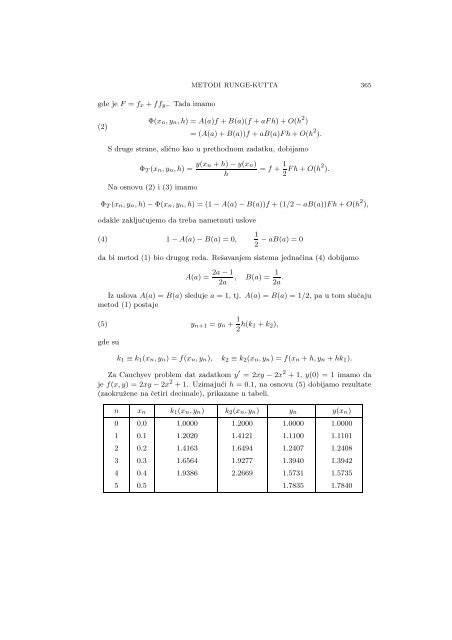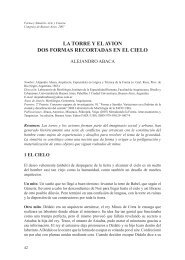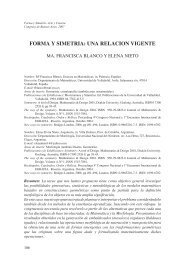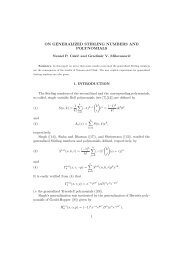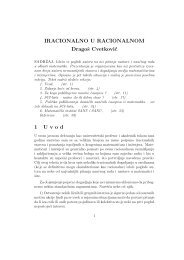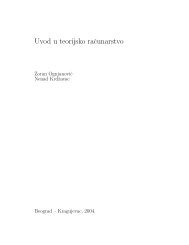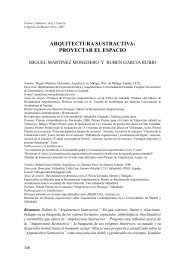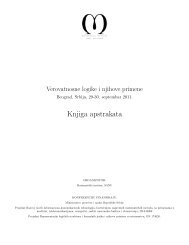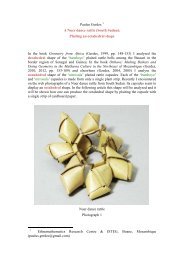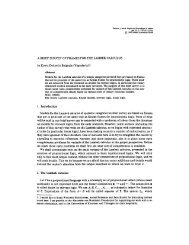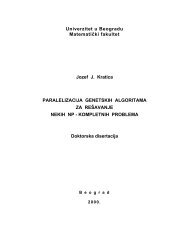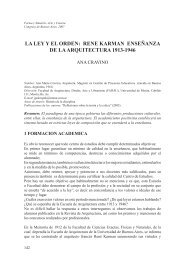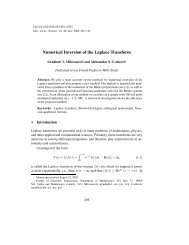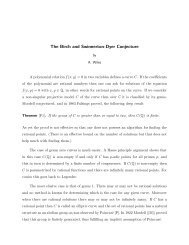- Page 1 and 2:
Gradimir V. MilovanovićMilan A. Ko
- Page 3 and 4:
viPREDGOVORProblemi iz interpolacij
- Page 5 and 6:
viiiSADRŽAJVIG L A V AInterpolacij
- Page 7 and 8:
2 UVODprimer, ETNA - Electronic Tra
- Page 9 and 10:
4 UVOD[1] G.V. Milovanović: Numeri
- Page 11 and 12:
6 OSNOVNI ELEMENTI NUMERIČKE MATEM
- Page 13 and 14:
8 OSNOVNI ELEMENTI NUMERIČKE MATEM
- Page 15 and 16:
10 OSNOVNI ELEMENTI NUMERIČKE MATE
- Page 17 and 18:
12 OSNOVNI ELEMENTI NUMERIČKE MATE
- Page 19 and 20:
14 OSNOVNI ELEMENTI NUMERIČKE MATE
- Page 21 and 22:
16 OSNOVNI ELEMENTI NUMERIČKE MATE
- Page 23 and 24:
18 OSNOVNI ELEMENTI NUMERIČKE MATE
- Page 25 and 26:
20 OSNOVNI ELEMENTI NUMERIČKE MATE
- Page 27 and 28:
22 OSNOVNI ELEMENTI NUMERIČKE MATE
- Page 29 and 30:
24 OSNOVNI ELEMENTI NUMERIČKE MATE
- Page 31 and 32:
26 OSNOVNI ELEMENTI NUMERIČKE MATE
- Page 33 and 34:
28 OSNOVNI ELEMENTI NUMERIČKE MATE
- Page 35 and 36:
30 OSNOVNI ELEMENTI NUMERIČKE MATE
- Page 37 and 38:
32 OSNOVNI ELEMENTI NUMERIČKE MATE
- Page 39 and 40:
34 OSNOVNI ELEMENTI NUMERIČKE MATE
- Page 41 and 42:
36 OSNOVNI ELEMENTI NUMERIČKE MATE
- Page 43 and 44:
38 OSNOVNI ELEMENTI NUMERIČKE MATE
- Page 45 and 46:
40 OSNOVNI ELEMENTI NUMERIČKE MATE
- Page 47 and 48:
42 OSNOVNI ELEMENTI NUMERIČKE MATE
- Page 49 and 50:
44 OSNOVNI ELEMENTI NUMERIČKE MATE
- Page 51 and 52:
46 OSNOVNI ELEMENTI NUMERIČKE MATE
- Page 53 and 54:
48 OSNOVNI ELEMENTI NUMERIČKE MATE
- Page 55 and 56:
50 OPŠTA TEORIJA ITERATIVNIH PROCE
- Page 57 and 58:
52 OPŠTA TEORIJA ITERATIVNIH PROCE
- Page 59 and 60:
54 OPŠTA TEORIJA ITERATIVNIH PROCE
- Page 61 and 62:
56 OPŠTA TEORIJA ITERATIVNIH PROCE
- Page 63 and 64:
58 OPŠTA TEORIJA ITERATIVNIH PROCE
- Page 65 and 66:
60 OPŠTA TEORIJA ITERATIVNIH PROCE
- Page 67 and 68:
62 OPŠTA TEORIJA ITERATIVNIH PROCE
- Page 69 and 70:
64 OPŠTA TEORIJA ITERATIVNIH PROCE
- Page 71 and 72:
66 NUMERIČKI METODI U LINEARNOJ AL
- Page 73 and 74:
68 NUMERIČKI METODI U LINEARNOJ AL
- Page 75 and 76:
70 NUMERIČKI METODI U LINEARNOJ AL
- Page 77 and 78:
72 NUMERIČKI METODI U LINEARNOJ AL
- Page 79 and 80:
74 NUMERIČKI METODI U LINEARNOJ AL
- Page 81 and 82:
76 NUMERIČKI METODI U LINEARNOJ AL
- Page 83 and 84:
78 NUMERIČKI METODI U LINEARNOJ AL
- Page 85 and 86:
80 NUMERIČKI METODI U LINEARNOJ AL
- Page 87 and 88:
82 NUMERIČKI METODI U LINEARNOJ AL
- Page 89 and 90:
84 NUMERIČKI METODI U LINEARNOJ AL
- Page 91 and 92:
86 NUMERIČKI METODI U LINEARNOJ AL
- Page 93 and 94:
88 NUMERIČKI METODI U LINEARNOJ AL
- Page 95 and 96:
90 NUMERIČKI METODI U LINEARNOJ AL
- Page 97 and 98:
92 NUMERIČKI METODI U LINEARNOJ AL
- Page 99 and 100:
94 NUMERIČKI METODI U LINEARNOJ AL
- Page 101 and 102:
96 NUMERIČKI METODI U LINEARNOJ AL
- Page 103 and 104:
98 NUMERIČKI METODI U LINEARNOJ AL
- Page 105 and 106:
100 NUMERIČKI METODI U LINEARNOJ A
- Page 107 and 108:
102 NELINEARNE JEDNAČINE I SISTEMI
- Page 109 and 110:
104 NELINEARNE JEDNAČINE I SISTEMI
- Page 111 and 112:
106 NELINEARNE JEDNAČINE I SISTEMI
- Page 113 and 114:
108 NELINEARNE JEDNAČINE I SISTEMI
- Page 115 and 116:
110 NELINEARNE JEDNAČINE I SISTEMI
- Page 117 and 118:
112 NELINEARNE JEDNAČINE I SISTEMI
- Page 119 and 120:
114 NELINEARNE JEDNAČINE I SISTEMI
- Page 121 and 122:
116 NELINEARNE JEDNAČINE I SISTEMI
- Page 123 and 124:
118 NELINEARNE JEDNAČINE I SISTEMI
- Page 125 and 126:
120 NELINEARNE JEDNAČINE I SISTEMI
- Page 127 and 128:
122 NELINEARNE JEDNAČINE I SISTEMI
- Page 129 and 130:
124 NELINEARNE JEDNAČINE I SISTEMI
- Page 131 and 132:
126 NELINEARNE JEDNAČINE I SISTEMI
- Page 133 and 134:
128 NELINEARNE JEDNAČINE I SISTEMI
- Page 135 and 136:
130 NELINEARNE JEDNAČINE I SISTEMI
- Page 137 and 138:
132 NELINEARNE JEDNAČINE I SISTEMI
- Page 139 and 140:
134 NELINEARNE JEDNAČINE I SISTEMI
- Page 141 and 142:
136 NELINEARNE JEDNAČINE I SISTEMI
- Page 143 and 144:
138 NELINEARNE JEDNAČINE I SISTEMI
- Page 145 and 146:
140 NELINEARNE JEDNAČINE I SISTEMI
- Page 147 and 148:
142 NELINEARNE JEDNAČINE I SISTEMI
- Page 149 and 150:
144 NELINEARNE JEDNAČINE I SISTEMI
- Page 151 and 152:
146 NELINEARNE JEDNAČINE I SISTEMI
- Page 153 and 154:
148 NELINEARNE JEDNAČINE I SISTEMI
- Page 155 and 156:
150 NELINEARNE JEDNAČINE I SISTEMI
- Page 157 and 158:
152 INTERPOLACIJA I APROKSIMACIJAza
- Page 159 and 160:
154 INTERPOLACIJA I APROKSIMACIJA6.
- Page 161 and 162:
156 INTERPOLACIJA I APROKSIMACIJALa
- Page 163 and 164:
158 INTERPOLACIJA I APROKSIMACIJARe
- Page 165 and 166:
160 INTERPOLACIJA I APROKSIMACIJAva
- Page 167 and 168:
162 INTERPOLACIJA I APROKSIMACIJAS
- Page 169 and 170:
164 INTERPOLACIJA I APROKSIMACIJAAk
- Page 171 and 172:
166 INTERPOLACIJA I APROKSIMACIJA(v
- Page 173 and 174:
168 INTERPOLACIJA I APROKSIMACIJAza
- Page 175 and 176:
170 INTERPOLACIJA I APROKSIMACIJAza
- Page 177 and 178:
172 INTERPOLACIJA I APROKSIMACIJARe
- Page 179 and 180:
174 INTERPOLACIJA I APROKSIMACIJARe
- Page 181 and 182:
176 INTERPOLACIJA I APROKSIMACIJAAk
- Page 183 and 184:
178 INTERPOLACIJA I APROKSIMACIJA(1
- Page 185 and 186:
180 INTERPOLACIJA I APROKSIMACIJAgd
- Page 187 and 188:
182 INTERPOLACIJA I APROKSIMACIJAgd
- Page 189 and 190:
184 INTERPOLACIJA I APROKSIMACIJAn
- Page 191 and 192:
186 INTERPOLACIJA I APROKSIMACIJARe
- Page 193 and 194:
188 INTERPOLACIJA I APROKSIMACIJAZa
- Page 195 and 196:
190 INTERPOLACIJA I APROKSIMACIJANa
- Page 197 and 198:
192 INTERPOLACIJA I APROKSIMACIJAk
- Page 199 and 200:
194 INTERPOLACIJA I APROKSIMACIJAPr
- Page 201 and 202:
196 INTERPOLACIJA I APROKSIMACIJAtj
- Page 203 and 204:
198 INTERPOLACIJA I APROKSIMACIJAPr
- Page 205 and 206:
200 INTERPOLACIJA I APROKSIMACIJATo
- Page 207 and 208:
202 INTERPOLACIJA I APROKSIMACIJAi
- Page 209 and 210:
204 INTERPOLACIJA I APROKSIMACIJApo
- Page 211 and 212:
206 INTERPOLACIJA I APROKSIMACIJAdo
- Page 213 and 214:
208 INTERPOLACIJA I APROKSIMACIJAk
- Page 215 and 216:
210 INTERPOLACIJA I APROKSIMACIJAa
- Page 217 and 218:
212 INTERPOLACIJA I APROKSIMACIJAod
- Page 219 and 220:
214 INTERPOLACIJA I APROKSIMACIJAod
- Page 221 and 222:
216 INTERPOLACIJA I APROKSIMACIJARe
- Page 223 and 224:
218 INTERPOLACIJA I APROKSIMACIJA(v
- Page 225 and 226:
220 INTERPOLACIJA I APROKSIMACIJADa
- Page 227 and 228:
222 INTERPOLACIJA I APROKSIMACIJAod
- Page 229 and 230:
224 INTERPOLACIJA I APROKSIMACIJAi
- Page 231 and 232:
226 INTERPOLACIJA I APROKSIMACIJAgd
- Page 233 and 234:
228 INTERPOLACIJA I APROKSIMACIJADa
- Page 235 and 236:
230 INTERPOLACIJA I APROKSIMACIJAAk
- Page 237 and 238:
232 INTERPOLACIJA I APROKSIMACIJAAp
- Page 239 and 240:
234 INTERPOLACIJA I APROKSIMACIJARe
- Page 241 and 242:
236 INTERPOLACIJA I APROKSIMACIJAOv
- Page 243 and 244:
238 INTERPOLACIJA I APROKSIMACIJApo
- Page 245 and 246:
240 INTERPOLACIJA I APROKSIMACIJAFo
- Page 247 and 248:
242 INTERPOLACIJA I APROKSIMACIJAdo
- Page 249 and 250:
244 INTERPOLACIJA I APROKSIMACIJAKo
- Page 251 and 252:
246 INTERPOLACIJA I APROKSIMACIJAPr
- Page 253 and 254:
248 INTERPOLACIJA I APROKSIMACIJAza
- Page 255 and 256:
250 INTERPOLACIJA I APROKSIMACIJARe
- Page 257 and 258:
252 INTERPOLACIJA I APROKSIMACIJANi
- Page 259 and 260:
254 INTERPOLACIJA I APROKSIMACIJARe
- Page 261 and 262:
256 INTERPOLACIJA I APROKSIMACIJAim
- Page 263 and 264:
258 INTERPOLACIJA I APROKSIMACIJASa
- Page 265 and 266:
260 NUMERIČKO DIFERENCIRANJE I NUM
- Page 267 and 268:
262 NUMERIČKO DIFERENCIRANJE I NUM
- Page 269 and 270:
264 NUMERIČKO DIFERENCIRANJE I NUM
- Page 271 and 272:
266 NUMERIČKO DIFERENCIRANJE I NUM
- Page 273 and 274:
268 NUMERIČKO DIFERENCIRANJE I NUM
- Page 275 and 276:
270 NUMERIČKO DIFERENCIRANJE I NUM
- Page 277 and 278:
272 NUMERIČKO DIFERENCIRANJE I NUM
- Page 279 and 280:
274 NUMERIČKO DIFERENCIRANJE I NUM
- Page 281 and 282:
276 NUMERIČKO DIFERENCIRANJE I NUM
- Page 283 and 284:
278 NUMERIČKO DIFERENCIRANJE I NUM
- Page 285 and 286:
280 NUMERIČKO DIFERENCIRANJE I NUM
- Page 287 and 288:
282 NUMERIČKO DIFERENCIRANJE I NUM
- Page 289 and 290:
284 NUMERIČKO DIFERENCIRANJE I NUM
- Page 291 and 292:
286 NUMERIČKO DIFERENCIRANJE I NUM
- Page 293 and 294:
288 NUMERIČKO DIFERENCIRANJE I NUM
- Page 295 and 296:
290 NUMERIČKO DIFERENCIRANJE I NUM
- Page 297 and 298:
292 NUMERIČKO DIFERENCIRANJE I NUM
- Page 299 and 300:
294 NUMERIČKO DIFERENCIRANJE I NUM
- Page 301 and 302:
296 NUMERIČKO DIFERENCIRANJE I NUM
- Page 303 and 304:
298 NUMERIČKO DIFERENCIRANJE I NUM
- Page 305 and 306:
300 NUMERIČKO DIFERENCIRANJE I NUM
- Page 307 and 308:
302 NUMERIČKO DIFERENCIRANJE I NUM
- Page 309 and 310:
304 NUMERIČKO DIFERENCIRANJE I NUM
- Page 311 and 312:
306 NUMERIČKO DIFERENCIRANJE I NUM
- Page 313 and 314:
308 NUMERIČKO DIFERENCIRANJE I NUM
- Page 315 and 316:
310 NUMERIČKO DIFERENCIRANJE I NUM
- Page 317 and 318:
312 NUMERIČKO DIFERENCIRANJE I NUM
- Page 319 and 320: 314 NUMERIČKO DIFERENCIRANJE I NUM
- Page 321 and 322: 316 NUMERIČKO DIFERENCIRANJE I NUM
- Page 323 and 324: 318 NUMERIČKO DIFERENCIRANJE I NUM
- Page 325 and 326: 320 NUMERIČKO DIFERENCIRANJE I NUM
- Page 327 and 328: 322 NUMERIČKO DIFERENCIRANJE I NUM
- Page 329 and 330: 324 NUMERIČKO DIFERENCIRANJE I NUM
- Page 331 and 332: 326 NUMERIČKO DIFERENCIRANJE I NUM
- Page 333 and 334: 328 NUMERIČKO DIFERENCIRANJE I NUM
- Page 335 and 336: 330 NUMERIČKO DIFERENCIRANJE I NUM
- Page 337 and 338: 332 NUMERIČKO DIFERENCIRANJE I NUM
- Page 339 and 340: 334 PRIBLIŽNO REŠAVANJE OBIČNIH
- Page 341 and 342: 336 PRIBLIŽNO REŠAVANJE OBIČNIH
- Page 343 and 344: 338 PRIBLIŽNO REŠAVANJE OBIČNIH
- Page 345 and 346: 340 PRIBLIŽNO REŠAVANJE OBIČNIH
- Page 347 and 348: 342 PRIBLIŽNO REŠAVANJE OBIČNIH
- Page 349 and 350: 344 PRIBLIŽNO REŠAVANJE OBIČNIH
- Page 351 and 352: 346 PRIBLIŽNO REŠAVANJE OBIČNIH
- Page 353 and 354: 348 PRIBLIŽNO REŠAVANJE OBIČNIH
- Page 355 and 356: 350 PRIBLIŽNO REŠAVANJE OBIČNIH
- Page 357 and 358: 352 PRIBLIŽNO REŠAVANJE OBIČNIH
- Page 359 and 360: 354 PRIBLIŽNO REŠAVANJE OBIČNIH
- Page 361 and 362: 356 PRIBLIŽNO REŠAVANJE OBIČNIH
- Page 363 and 364: 358 PRIBLIŽNO REŠAVANJE OBIČNIH
- Page 365 and 366: 360 PRIBLIŽNO REŠAVANJE OBIČNIH
- Page 367 and 368: 362 PRIBLIŽNO REŠAVANJE OBIČNIH
- Page 369: 364 PRIBLIŽNO REŠAVANJE OBIČNIH
- Page 373: 368 PRIBLIŽNO REŠAVANJE OBIČNIH


